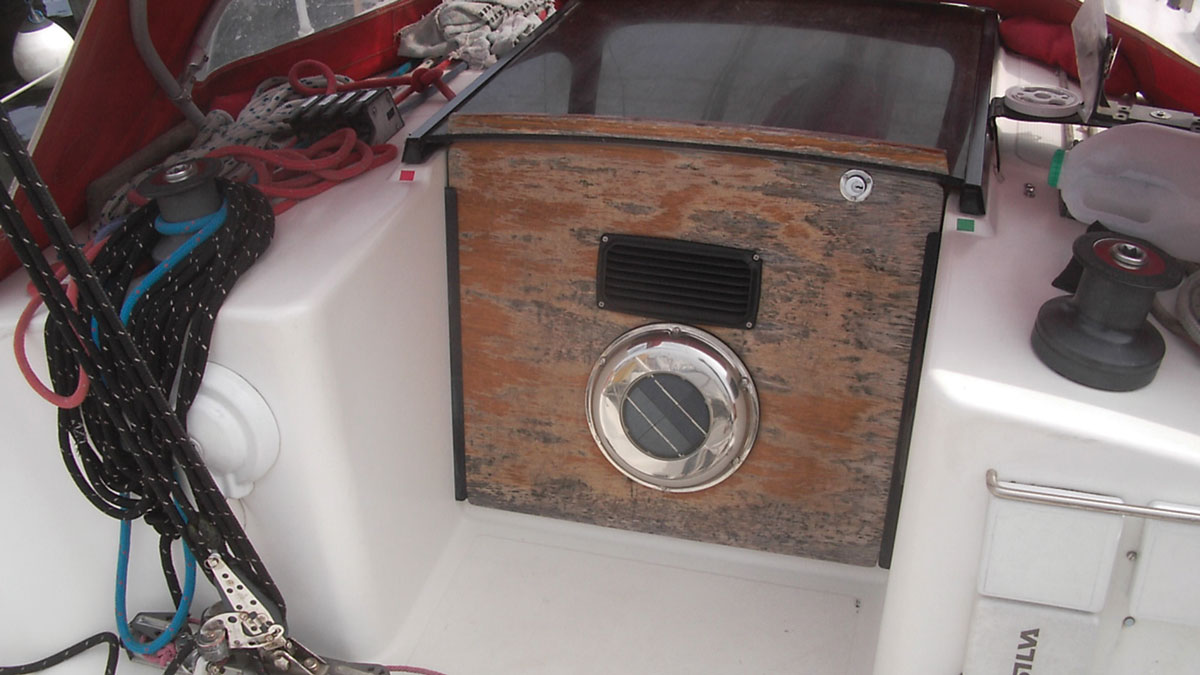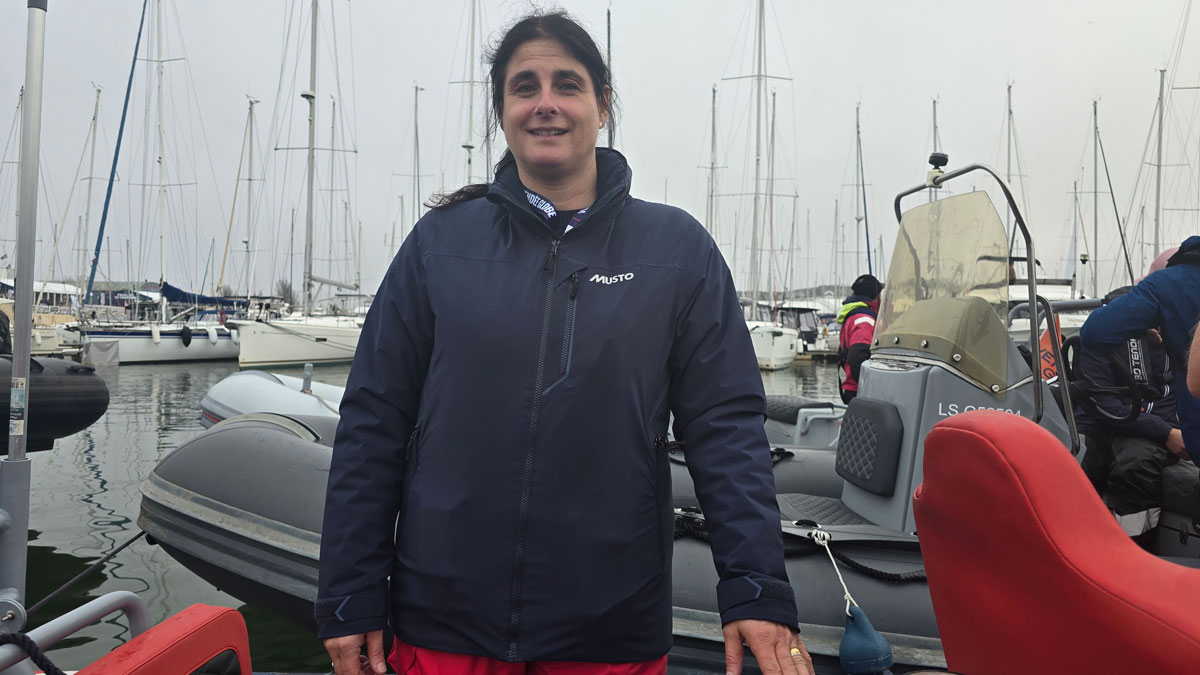Staying afloat this winter? Ali Wood has some top tips for keeping warm while winter sailing
British fell walker Alfred Wainwright famously said “There’s no such thing as bad weather, only unsuitable clothing.”
Of course, bad weather is very much a ‘thing’, especially for us sailors, but it can certainly be mitigated by the right sailing gear and good practice.
Whether it’s installing a heating system, sipping soup from a Thermos or a good old pair of woolly socks there are plenty of ways to make winter sailing more comfortable, whatever your boat.
Dinghy clothing for winter sailing
Keeping warm is about layering, explains Matthew Rich from Andark Diving and Watersports.
“A lot of the products we do now are breathable, and it’s about making sure you wear individual layers so on a colder day you wear several items and on a warmer day, a lot less.”
Staying dry as long as possible is crucial. Next to your skin, a fleecy rash vest will wick away moisture while also providing a layer of warmth.
On top of that dinghy and small-boat sailors tend to wear a wetsuit or ‘hikers’ (neoprene pants with reinforcement).

Winter spraytops for dinghy sailors can be fleecy
I’m a fan of long john style wetsuits, which you can wear in the summer with bare arms, and in the winter with additional layers such as a long-sleeved neoprene top and/or an outer layer waterproof spraytop.
“Spraytops keep the wind off, and some have fleece in them too,” Matthew adds. “I’d recommend the fleecy spraytops, especially for the upwind leg, where the wind can have a real bite to it.”
Indeed, when dinghy sailing, I find a basic spraytop, such as Decathlon’s Tribord Sailing Smock, is fine for spring through to autumn, but for winter sailing I switch to my Typhoon fleece-lined top which is actually too hot most of the year!
At the top end of the dinghy sailor’s budget is a dry suit which has flexible rubber seals around the neck and wrists and works by keeping water out altogether.
As they fit more loosely than wetsuits, the benefit of these is you can wear whatever you like underneath.
Cruiser clothing for winter sailing
For sailing yachts and motorboats, the same rule applies: layer up, but of course, the clothing is designed for much longer spells at sea.
Salopettes, a coastal jacket and boots, which can be worn over a variety of layers, will keep the wind and water out. Unfortunately, a highly waterproof outer layer is not necessarily a warm one, which is why you need to combine clothing.
The advantage of layers is you can remove them when doing something exertive, such as winching in sails, then put them back on for the chillier upwind leg. It’s much easier to take off a jacket than warm yourself up once cold.
Outer layers for winter sailing
PBO’s gear editor, Rupert Holmes, loves winter sailing, whether it’s frosty weekends in Newtown Creek, the East Coast rivers, or even a quick cross-Channel trip if conditions allow.
He emphasises the importance of staying dry. “Older or well-used foul weather gear that absorbs moisture when wet will result in heat loss from evaporation and will not be properly breathable,” he warns.
“In contrast, newer kit where the water beads off the surface will keep you warm for much longer and will still have the designed level of breathability.”

Make sure your outer layer is waterproof, otherwise it could make you cold quickly. Credit: Marsali Taylor
PBO’s engine expert Stu Davies is a fan of Decathlon’s reasonably priced breathable oilskins.
He says: “The vast majority of UK sailors will never need bluewater sailing protection… people pay way too much for gear that is mostly used as bragging rights in the club bar!”
All wet weather gear, no matter which brand, will eventually stop working if the pores that wick away sweat get clogged.
Fabrics such as Gore-Tex can be restored with a 40°C wash but you’ll then need to iron or tumble dry on a low heat to reactivate the durable water-repellent (DWR) coating.
After a few washes, replace the DWR with a liquid or spray such as Nikwax or Wash N Proof.
You’ll know it’s working when the water beads up again and rolls away, rather than soaking into your jacket.
Mid layers to keep you warm while winter sailing
A woollen or fleece jumper works well over salopettes. Wool has the benefit of not holding sweat, which PBO editor Katy Stickland discovered when she wore her Arthur Beale Guernsey for four days solid in the North Sea.
“It was snug and warm but not too tight under the arms or on the dropped shoulders (which are traditional in all Guernsey jumpers),” she said.

Traditional wool is excellent for keeping you warm; plus if the wool is untreated, like the wool used to knit the Arthur Beake Guernsey, it doesn’t hold sweat
Another option, says Matthew Rich, is a built-up membraned mid-layer, such as a jacket containing PrimaLoft.
“PrimaLoft is a material that will actually generate warmth in your body, so you don’t need as many layers.”
If you’re not likely to get wet, then a PrimaLoft garment, such as Musto’s BR1 jacket, may be a good mid-to-outer layer, with your heavier coastal jacket kept down below in case the weather turns.
Gilets, such as Helly Hansen’s Crew Vest also make an excellent mid-layer. Worn over a base layer, they keep your core warm in a wide range of temperatures without restricting movement.
On my summer boating holiday on the windy Canal du Midi, I wore my gilet over a T-shirt, and for winter safety boating, it will be over a fleece.
Katy swears by her battery-powered iHeat gilet, which has four heating zones. “It’s wind and waterproof and has three temperature settings so I never get overheated,” she says. “The battery life lasts six hours on the highest settings and it’s machine washable.”
Don’t forget your bottom half, adds Rupert. “Our legs have a large surface area and are therefore responsible for a lot of heat loss. Midlayer salopettes can be a game changer, although they tend to be quite expensive, so an all-in-one fleece of the type sold to go under drysuits can be a much more cost-effective option.”
Winter sailing base layers
Big-boat sailors need a thermal base layer (top and leggings). You can find these for all budgets.
I’m a big fan of my EDZ Merino wool thermals but have been equally impressed by low-cost synthetic thermals from Primark.

Merino wool base layers are ideal for winter sailing as it has natural moisture-wicking properties so you will never get cold and clammy
You can buy thermal layers at a range of high street stores, from Marks & Spencer to Decathlon.
The important thing is that they’re close-fitting enough to trap warmth while allowing freedom of movement.
Warm hands
It sounds obvious, but it’s worth repeating: dry equals warm. At my dinghy club, we often wear Marigolds under our sailing gloves and not because we’re on washing-up duty – it’s surprisingly effective!
If your hands are going to be regularly submerged, then neoprene diving gloves aren’t a bad idea for dinghy sailors but they will wear out quickly if not reinforced.

Ali wears the Sealskinz waterproof hat and gloves in Christchurch Harbour
If you need grip and dexterity for rope handling, stick to sailing gloves.
For cold-weather cruising, I love my Sealskinz Gauntlet gloves, but if you’re doing fiddly jobs and always having to take them on and off, a thinner pair would be more suitable.
The lining can be a beast to wiggle wet fingers into!
Hot heads
While there’s much debate as to how much heat is lost through the head (apparently less than you might think), no-one would argue that a hat is a bad idea!
When they’re wet, however, hats are much less effective, so take plenty. A wide-fitting cap over the top will help keep it dry.
Alternatively, invest in a waterproof hat such as the excellent Sealskinz beanie, which is a favourite of mine.
For reading in bed, PBO contributor Gilbert Park recommends a beanie hat with a rechargeable LED headlamp. There are a surprising number available online.
Toasty feet
Cold feet are hard to warm up. For dinghy sailing I’ve been impressed with waterproof Sealskinz socks – though the neoprene is so thick it’s hard to get them on under boots.
Alternatively, just go for the thickest neoprene socks or booties you can find (type ‘diving socks’ into Google).
Dinghy boots are good if you need grip and decent soles – get 5mm neoprene if you can.

Gilbert Park swears by these fleece-lined socks
Woolly (hiking) socks are good under wellies, and better than cotton when wet.
Take spare pairs. If you’re buying new boots, try them first with thick socks. You might need to go up a size.
For padding around the cabin, nothing cools you quicker than an icy floor.
Wear slippers or fleece-lined slipper socks with a rubber sole as Gilbert Park does on his Mitchell 28 motorboat. And don’t forget the bed socks for bedtime.
Sleeping bag
“Invest in a large (wide) sleeping bag,” says Gilbert. “You’ll spend much longer in it during the winter than you will in the summer and it lets you move around. Mine also has a hood.”
While a larger sleeping bag may not trap as much heat, bear in mind that you may need to sleep fully clothed, especially if doing watches.
For extra cosiness, pop a hot water bottle in the bottom.
Hot water bottles
Sea swimmer instructor Helena Eflerova has designed her own ‘wearable’ hot water bottle, available at heaquatics.com/store, though any 1-2lt hot water bottle in a fleece cover (to prolong warmth) will be a godsend on cold days – not just at bedtime!
Similarly, reusable hand warmers, such as Lifesystem’s gel pads, can be kept in your pockets for 45 minutes of warmth. To reset them, simmer in boiling water.
Warm food to keep out the cold while winter sailing
I’ll never forget the Jamie Oliver chilli that Gilbert’s wife Maire made for us when we sailed the PBO Project Boat to Poole one autumn.
The spicy sweet potato dish warmed us up a treat.
One-pots and soups can be kept warm in a thermos flask and if you’re sailing solo or on watch, you can keep it in the cockpit for easy access.

Keep up crew morale by serving plenty of warming dishes on board
Hot drinks and high-energy snacks will keep you warm and alert.
After a winter sea swim, I often warm up with a coffee and a doughnut. Note, though, that caffeine is a diuretic, and it’s never fun trying to take off oilies for a wee!
A healthier alternative, recommended by Helena, is a flask of hot water mixed with grated ginger, lemon and honey.
Or, if you don’t have the time, Pukka’s Turmeric Active and Ginger tea will do the trick.
Low-energy cookers
If you’re cooking on board, consider low-energy appliances such as the Remoska, which draws 650W and can cook sausages and casseroles, or the Mr D thermal cooker which cooks for up to seven hours without an external heat source.
Pasties, pies and sausage rolls are easy to heat in the oven, or if you’ve a hob, a simple Pot Noodle or can of tomato soup will lift the spirits.
My kids’ favourite are hotdogs, which I boil, then keep in a vacuum flask.
With a jar of hotdogs and a pack of finger rolls, you can feed a large crew very quickly, and the food will stay hot for hours in a flask.
Planning winter sailing
Don’t be too ambitious. With fewer daylight hours, stick to short sails. For longer passages, set off before dawn rather than arriving, cold and tired, after dark.
Keep watches short so crew can go below and warm up. Be safety conscious, too.
The water in the UK will be cold right through to May. Wear lifejackets, clip on and minimise time out of the cockpit.
A dry boat is a happy boat
Staying dry is just as important for the boat as it is for the crew. A damp boat may be unavoidable on passage, but there are things that can help on the mooring.
If you have shorepower, run a low-energy bar heater and prop cushions on their side. PBO technical editor Fox Morgan rates the Meaco DD8L Junior dehumidifier.
“This desiccant model has proved very popular among boat owners because of its light weight (6kg/13lb), low noise and efficiency at low temperatures.”
As high latitude sailor Richard Rogers found, condensation can wreck expensive equipment, and grow unhealthy mould. “When the smell gets into your clothes, it drains your morale,” he says.
Richard tackled this by insulating the hull of his Morgan Giles, Aurora with a low-density polyethylene foam called Plastazote.
Above decks
A good (clean!) sprayhood is essential for protection from the elements. Make sure the companionway is closed and watertight.
A cockpit tent can create much more usable space.
In summer it might mean protection from the sun or extra berths to camp out, but it can be just as beneficial in winter.

A sprayhood is essential for protecting you from the elements while winter sailing. Credit: Graham Snook/Future
According to Sverre Bech-Sjøthun (sailingselkie.no), most cruisers in Norway have some sort of full cockpit enclosure to protect them from the elements.
“In the winter it’ll act as a buffer zone making your entire aft section much warmer, and when the sun peaks out, it’ll act as a greenhouse, creating a really nice warm place to sit and enjoy the scenery, even if it’s literally freezing.”
PBO’s Stu Davies agrees. “The best thing we ever did was put a cockpit tent on our boat when we were in Pwllheli; shirt sleeve sailing in the worst of conditions! The maker [JKA sailmakers, now closed] was horrified that we were thinking of sailing with it up. He was a racing purist. We crossed Biscay with it up, and lived in it for three days!”
Heaters and dangers
There are many options for heating your boat. Rupert Holmes has a simple charcoal heater on his Discovery 3000 Ammos.
“It’s not as convenient as a more sophisticated warm air-type system, but took only two hours to fit, needs next to no maintenance and a €5 bag of lumpwood charcoal lasts the best part of a week.”
Gilbert has an alcohol heater when at anchor (but won’t run it while asleep) and in the marina runs an oil heater.
Combustible fuels need sufficient air to burn safely. We hear reports every year about carbon monoxide poisoning from heating appliances, whether through faulty exhausts fitted to marine diesel heaters, blocked flues or, for example, a kerosene heater running in an unventilated space.
Marine surveyor Ben Sutcliffe-Davies recommends a CO detector be fitted in every cabin. Test them routinely and never remove batteries except to replace them.
Carbon monoxide on a boat: how to protect you and your crew
John Tylor and PBO’s experts share some valuable safety tips for avoiding carbon monoxide on a boat
Banish winter damp: install a solar-powered vent
Ten years ago, Colin Haines installed a solar-powered vent on his boat. He shares the results and if it still…
Boat maintenance: jobs to tackle over the winter
Now’s the time to tick-off those jobs you’ve been putting off all season and get a head-start on the spring…
I tested the new Musto BR1 Primaloft® Mid-Layer Jacket to see if it was as waterproof and warm as the claims
Three hours on the start line of a yacht race and then walking in Storm Bert gave me the chance…
Want to read more articles like Winter sailing: top tips to keep you as snug as a bug on the water?

A subscription to Practical Boat Owner magazine costs around 40% less than the cover price.
Print and digital editions are available through Magazines Direct – where you can also find the latest deals.
PBO is packed with information to help you get the most from boat ownership – whether sail or power.
-
-
-
- Take your DIY skills to the next level with trusted advice on boat maintenance and repairs
- Impartial in-depth gear reviews
- Practical cruising tips for making the most of your time afloat
-
-
Follow us on Facebook, Instagram, TikTok and Twitter








